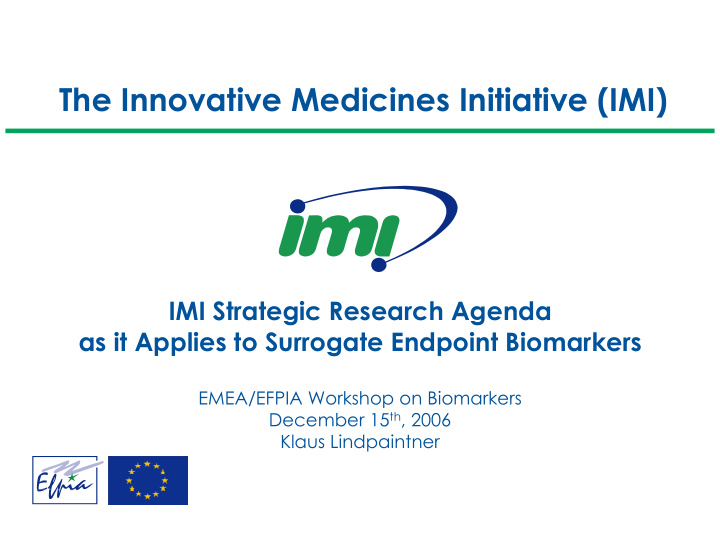



The Innovative Medicines Initiative (IMI) IMI Strategic Research Agenda as it Applies to Surrogate Endpoint Biomarkers EMEA/EFPIA Workshop on Biomarkers December 15 th , 2006 Klaus Lindpaintner
The Drivers for a New R&D Model of Public-Private Partnership • Important novel opportunities from genomics and related disciplines • Timelines and cost of drug development • The potential of increased cooperation among stakeholders � Creation of IMI by EFPIA and the EC 2
The IMI Strategic Research Agenda http://www.imi-europe.org • Developed by over 350 stakeholders • Identifies bottlenecks and associated pre-competitive opportunities in the R&D process • Proposes recommendations to address this bottlenecks • Proposes a new model of Public- Private collaborations to implement the recommendations 3
Science and technology advances present significant opportunities ‘- ‘ -omics omics’ ’ Better understanding of Public disease/drug mechanisms investment More efficient drug discovery and development Understanding Pre-competitive human collaborative physiology research Better medicines, faster Imaging Imaging Health benefits for patients Private investment ICT ICT 4
The Research Focus of IMI Discovery Discovery Discovery Preclinical Preclinical Preclinical Translational Translational Translational Clinical Clinical Clinical Pharmaco- Pharmaco- Pharmaco- research research research develop. develop. develop. medicine medicine medicine develop. develop. develop. vigilance vigilance vigilance Knowledge Management Education & Training Benefit/Risk Benefit/Risk Predictive Predictive Predictive Predictive Predictive Predictive Identification Identification Patient Patient Validation of Validation of assessment assessment pharmacology pharmacology pharmacology toxicology toxicology toxicology of biomarkers of biomarkers recruitment recruitment biomarkers biomarkers with regulatory with regulatory authorities authorities Efficacy Efficacy Safety Safety 5
Disease Focus Predictive Predictive Predictive Predictive Predictive Predictive Identification and Identification and Identification and Patient Patient Patient Benefit / Risk Benefit / Risk Benefit / Risk pharmacology pharmacology pharmacology toxicology toxicology toxicology validation of validation of validation of recruitment recruitment recruitment assessment assessment assessment biomarkers biomarkers biomarkers Cancer Cancer Brain Brain Disorders Disorders Inflammatory Inflammatory Diseases Diseases Metabolic Metabolic Diseases Diseases Infectious Infectious Diseases Diseases 6
IMI Recommendations concerning the identification and validation of biomarkers • Create disease-specific imaging networks • Develop systems biology approaches, i.e. disease mechanistic modelling and simulation • Stimulate translational medicine in an integrated fashion incl. new ways and tools for conducting clinical trials • Create Regional Biomarker Centres and Communities of Experts for the identification and validation of biomarkers and novel targets • Develop biomarker database to underpin the validation process • Develop partnership with regulators for innovative clinical trial design and acceptance of biomarkers, where appropriate 7
Example of a IMI Patient Centred Project: Validation of a New Biomarker Identification Validation Adoption Objective Experimental Approach Workshop Workshop Medicine Academia Industry EMEA Leadership Patients/ Patients/ Industry/ Participants EMEA/ Industry/ Clinicians Clinicians Clinicians 8
“Validation” of Biomarkers Sampler form the Roche Experience • Biomarkers for efficacy likely relevant/successful if identified early on – Example: trastuzumab and HER2 expression test • Biomarkers for efficacy in serious indications must deliver high information content lest they will result in inappropriate denial of treatment – Example: erlotinib and EGFR mutations • Biomarker “Target Product Profile” important to define – Major dependencies on indication (serious vs. trivial) and use (ADR vs. efficacy) – Differentiated approach paramount 9
Biomarker Target Product Profile: Primum non nocere • Trivial indications: nocere = inappropriate treatment – ADR: avoid at all cost (inappropriate withholding of drug o.k.) � high sensitivity, specificity less important – Efficacy: don’t treat unless you are sure the drug will work � high specificity, sensitivity less important • Life-threatening indications: nocere = inappropriate withholding of treatment – ADR: do not withhold drug inappropriately (only if very high risk of ADR) � high specificity, sensitivity less important (example Abacovir) – Efficacy: do not withhold drug inappropriately (only if very low odds of response) � high sensitivity, specificity less important (example Herceptin) 10
Benefits of IMI for Validation of Biomarkers • Leverage pre-competitive knowledge that was previously out of reach • Leverage trial data to reach requisite size for statistical power • Earlier application of new technologies to regulatory practices • Regulators to be involved earlier in the process • Increased collaboration among all relevant stakeholders � More biomarkers, validated faster 11
Resource strategy • € 460M per year x 7 years in direct, in-cash funding to academia, patient organizations, and SMEs • Contingent on matching funds in-kind from industry in collaborative, pre/pro-competitive projects • A major opportunity for European science, as well as a tall challenge
Benefits of Increased Collaboration for All Stakeholders • Access to pre-competitive knowledge that was previously out of reach • Stimulation of creativity • Achievement of critical mass • Shared risk of failure • Enhanced learning experience � Generation of More Innovative Solutions 13
The Ultimate Beneficiaries ... … All EU citizens 14 14
Recommend
More recommend